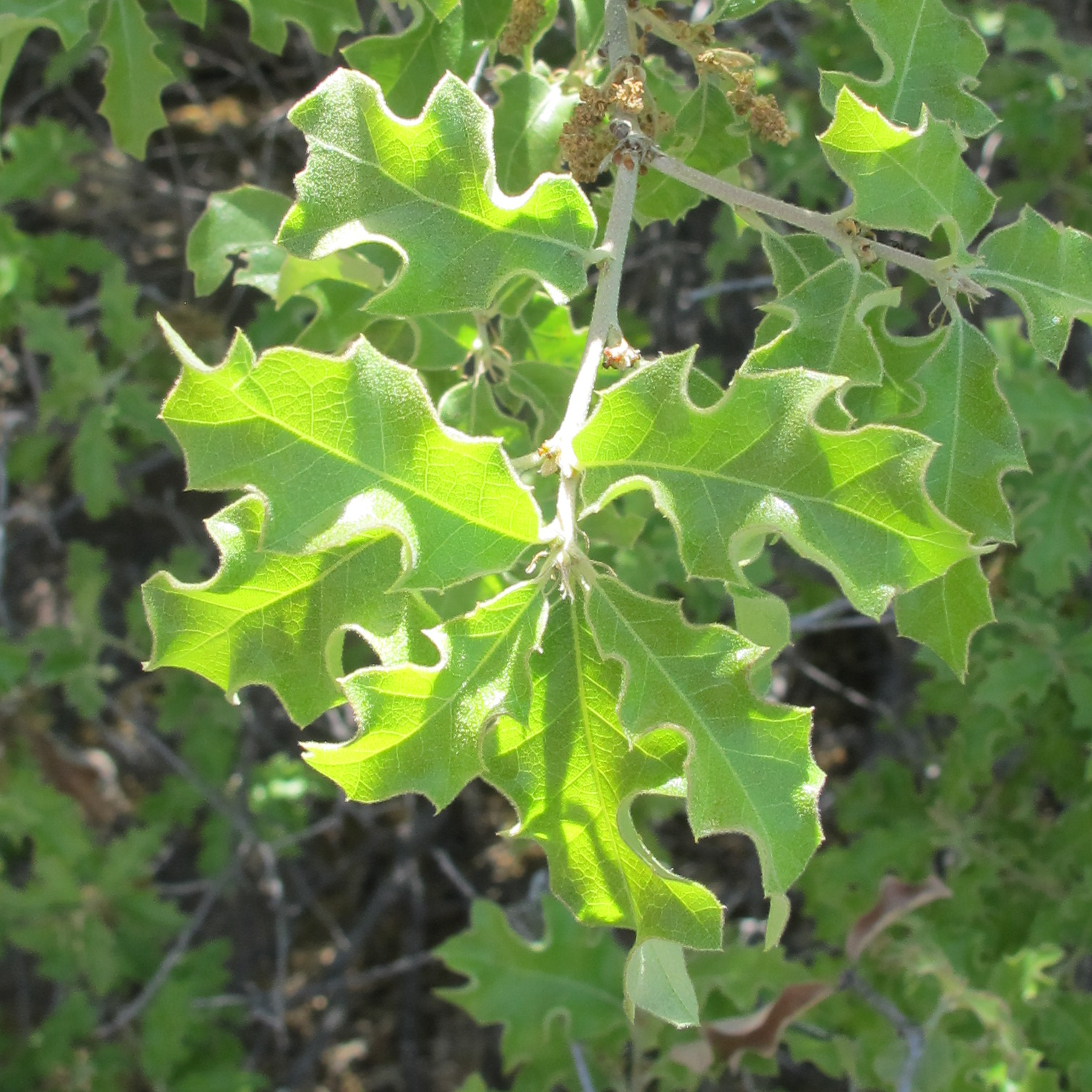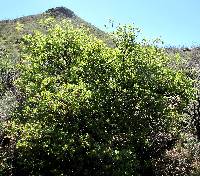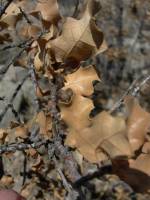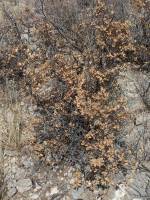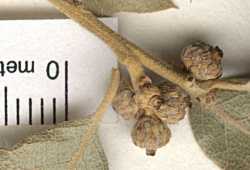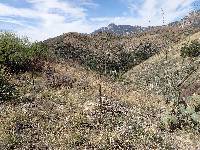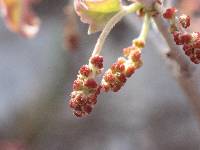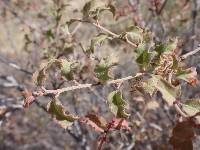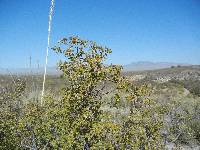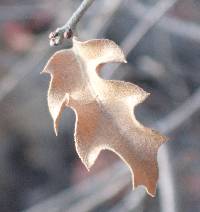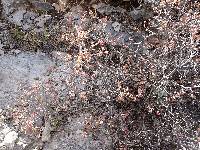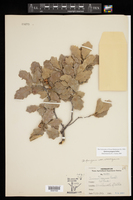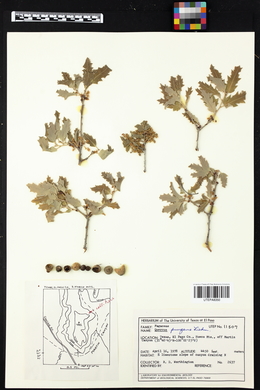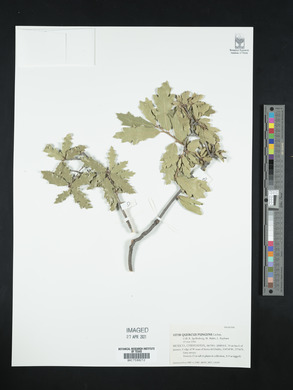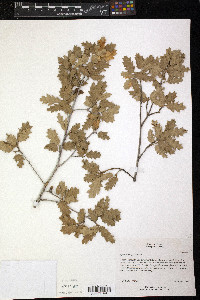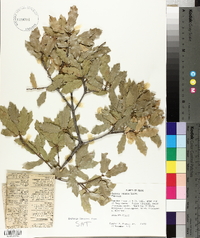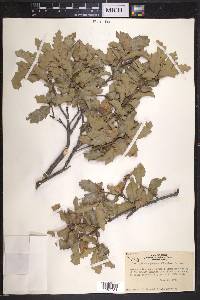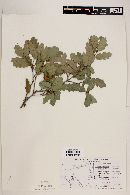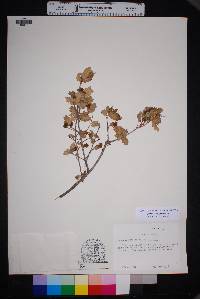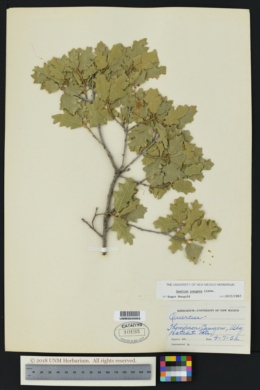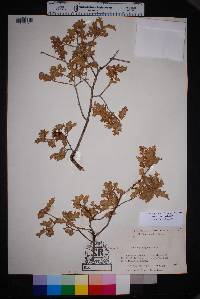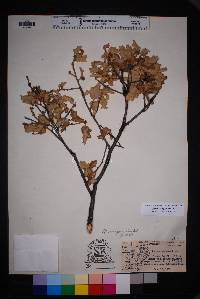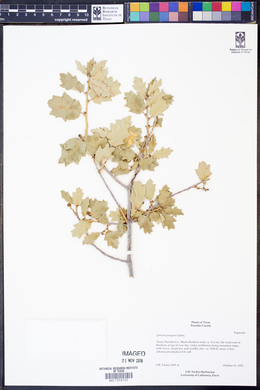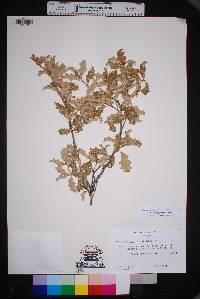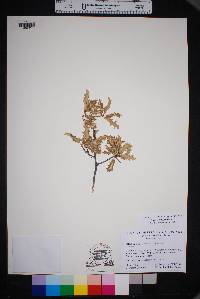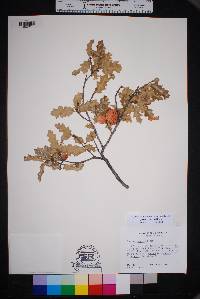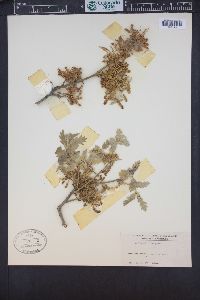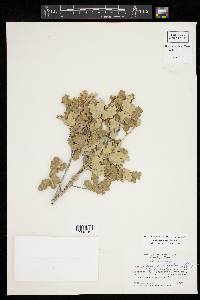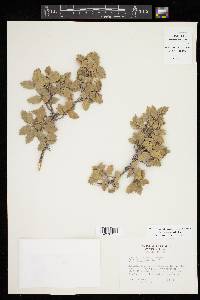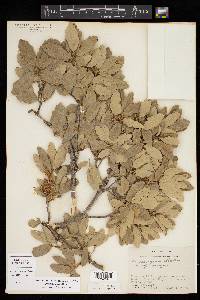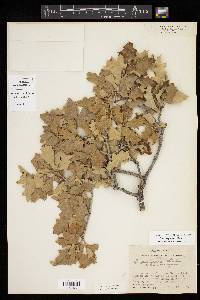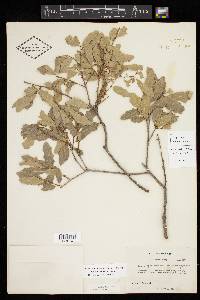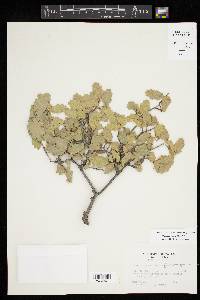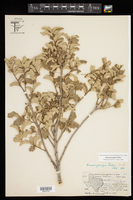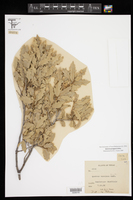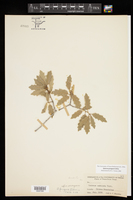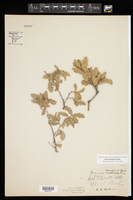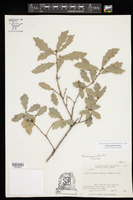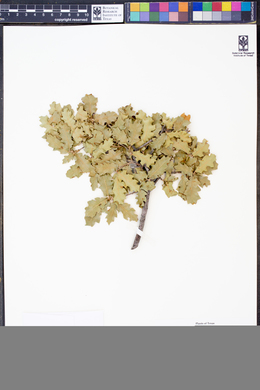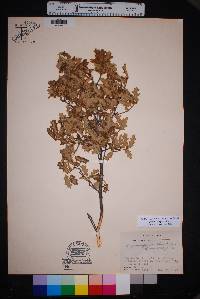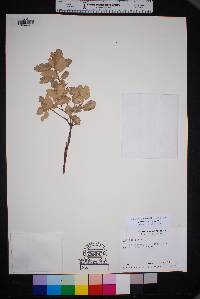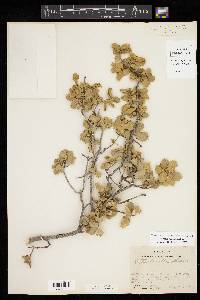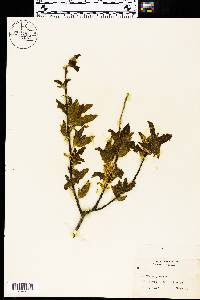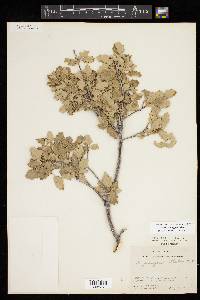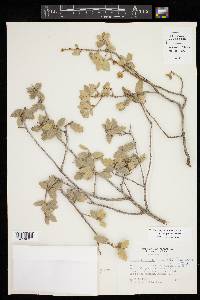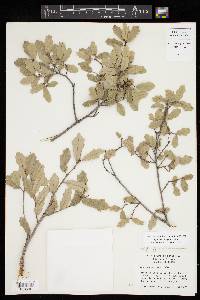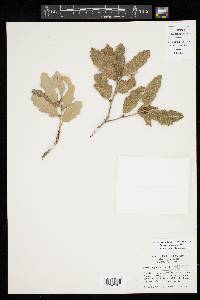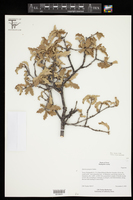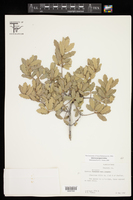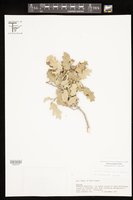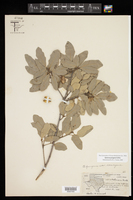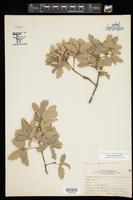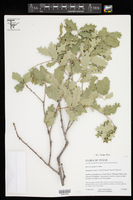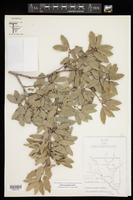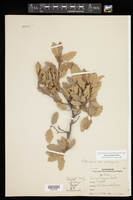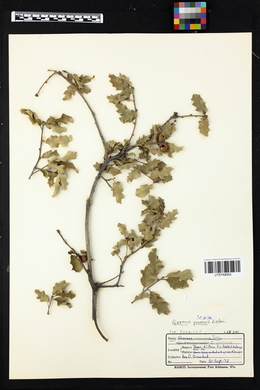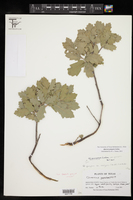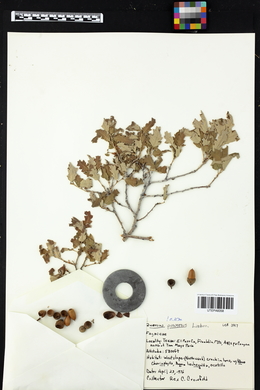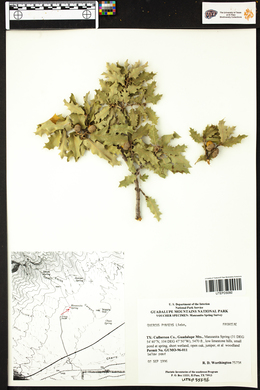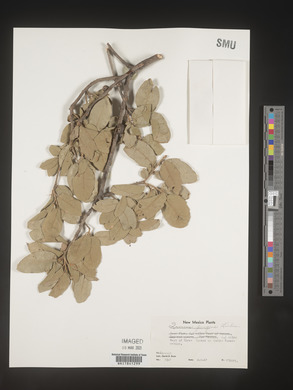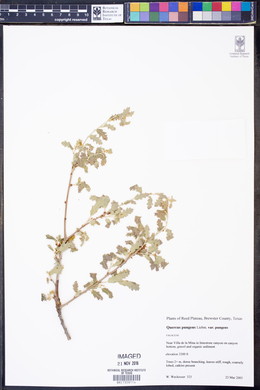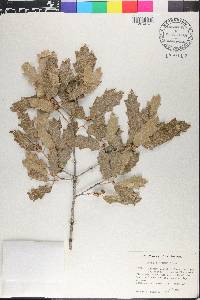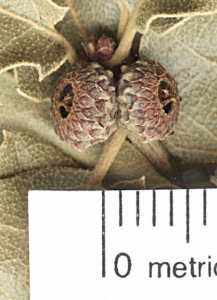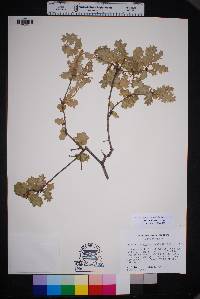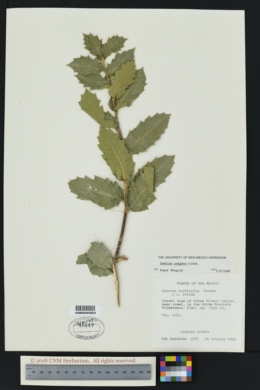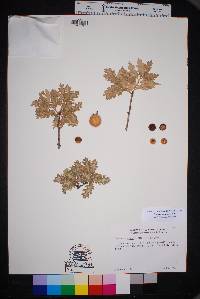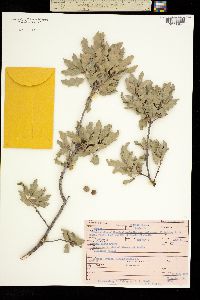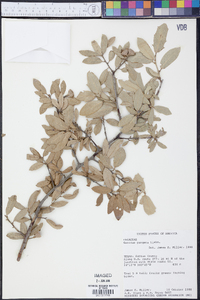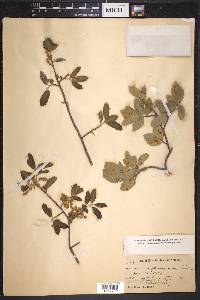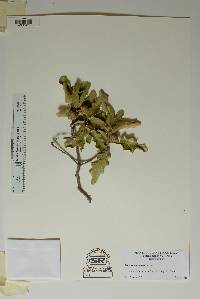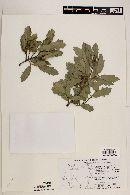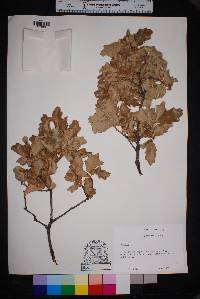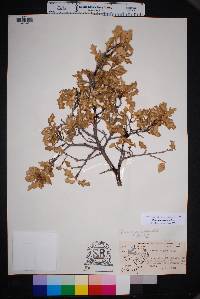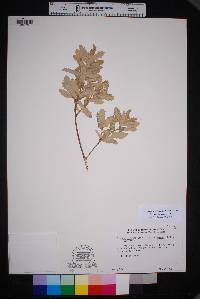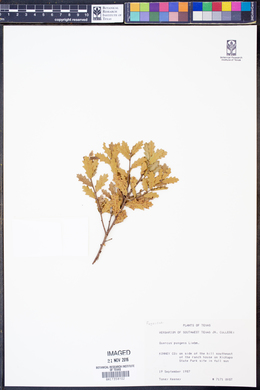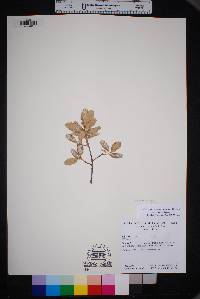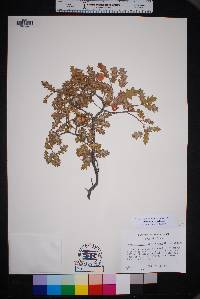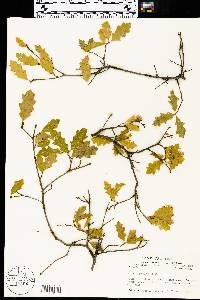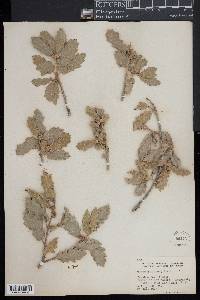Quercus pungens
|
|
|
|
Family: Fagaceae
pungent oak, more...Sandpaper Oak, scrub oak (es: encino chino)
[Quercus pungens var. pungens, moreQuercus undulata var. pungens (Liebm.) Engelm., Quercus undulata var. wrightii Engelm.] |
Shrubs or moderate-sized trees , evergreen or subevergreen. Bark light brown, papery. Twigs gray, 1-2 mm diam., short velvety-tomentose, glabrate with age. Buds dark red-brown, ca. 2 mm, sparsely pubescent. Leaves: petiole to 10 mm. Leaf blade elliptic to oblong, 10-40(-90) × 10-20(-40) mm, rather thick, leathery, stiff, base rounded or minutely cordate, very rarely cuneate, margins regularly undulate-crisped, not revolute, coarsely toothed or incised with acute teeth or spinose lobes, secondary veins 5-8(-14) on each side, usually branched before passing into teeth, apex acute or obtuse, rarely rounded, spine-tipped; surfaces abaxially canescent, usually densely stellate-pubescent, and mixed with stiff, harsh, stellate hairs, often sandpapery to touch, rarely glabrate, adaxially yellowish green, glossy, usually rough and sandpapery because of minute, persistent hair bases, rarely glabrate. Acorns subsessile or on peduncle to 3 mm; cup shallowly to deeply cup-shaped or turbinate, to 8 mm deep × l3 mm wide, covering ca. 1/4 nut, margin thin, scales reddish brown, moderately tuberculate or keeled, densely gray-tomentose; nut light brown, broadly ovoid to subcylindric, to 10 × 10 mm, apex rounded to subacute, glabrous. Cotyledons distinct. Flowering spring. On dry limestone or igneous slopes, usually in oak, pinyon, and juniper woodlands, chaparral, and sometimes descending into desert vegetation; 800-2000 m; Ariz., N.Mex., Tex.; Mexico (Chihuahua and Coahuila). Numerous populations appear to be hybrid swarms between Quercus pungens and Q . vaseyana , which is sometimes treated as a variety of Q . pungens . No other evidence for a close relationship exists for these two species, and such a treatment risks erecting a polyphyletic assemblage. To the west and south within the range of Q . pungens no indication of introgression exists, and the two species are strikingly different and easily separable. I interpret the contact as secondary.
Plant: shrub; 1-2 m high, the bark light gray, somewhat flaky when older; young twigs densely woolly (rarely subglabrous), the older twigs glabrescent within about 2 years, purplish-gray to gray, more or less smooth Leaves: lobed, elliptic to oblong, 1.5-5 cm long, 0.8-4 cm wide, 1.2-2.4 times as long as wide, densely woolly below, moderately covered with hairs above (rarely subglabrous), persisting about 1 year, the lobes 2-5 per side, the sinuses reaching 25-60% of the way to the midvein; stellate hairs of lower leaf surface with 8-20 arms; apex acute, obtuse, or truncate; base acute to subcordate; petiole 1-6 mm long, sparsely to densely woolly; midvein raised to nearly flat above, prominent below; lateral veins nearly flat above, raised below; secondary veins forming a reticulate pattern, usually obscured by hairs below; blade coriaceous, lustrous above (at least beneath hairs); margin undulate, with ca. 1 undulation per lobe and adjacent sinus, the lobe-apex shortly spinescent INFLORESCENCE: staminate flowers in aments; pistillate flowers solitary or in groups on spikes, these sometimes abbreviated, each pistillate flower with a separate involucre Flowers: mostly wind-pollinated, unisexual, the perianth much reduced or absent; staminate flowers in heads or aments, the perianth greenish, the stamens 3-4; pistillate flowers usually tricarpellate, solitary or in clusters of about 3 or more, subtended individually or in groups by an involucre that develops into a woody cupule enclosing or subtending the mature fruit(s) Fruit: ACORNS 1-1.5 cm long, solitary or in pairs; cap about hemispheric, ca. 5-8 mm long, 8-12 mm wide, inner surface densely appressed pubescent, the hairs about straight; scales with thickened bases; nut-shell subglabrous within Misc: Chaparral, typically on limestone hills; 1050-1650 m (3400-5500 ft); Apr (fr. Sep-Oct) REFERENCES: Landrum, Leslie R. Fagaceae. 1994. J. Ariz. - Nev. Acad. Sci. Volume 27, 203-214 Landrum 1993, FNA 1997 Common Name: pungent oak Duration: Perennial Nativity: Native Lifeform: Tree General: Shrub 1-2 m high, bark light gray, flaky when older, young twigs densely woolly, rarely subglabrous, the older twigs glabrescent within about two years, purplish gray to gray, more or less smooth. Leaves: Lobed, elliptic to oblong, 1.5-5 cm long, 0.8-4 cm wide, 1.2-2.4 times as long as wide, densely woolly below, yellowish-green glossy above; persisting about 1 year, lobes 2-5 per side, each sinus reaches about a quarter to more than half way to the midvein; apex acute to truncate, base acute to subcordate, petiole 1-6 mm long, veins prominent below, blade leathery, margin undulate. Flowers: Staminate flowers with calyx 2-6 lobed, pistillate flowers with calyx adnate to ovary. Fruits: Annual maturation of acorns 1-1.5 cm long, solitary or in pairs, cap hemispheric, 5-8 mm long, 8-12 mm wide, inner surface densely appressed pubescent, hairs about straight; scales with thickened bases. Ecology: Often found on limestone soils, often in chaparral, oak, and juniper communities from 3,500-5,500 ft (1067-1676 m); flowers in spring. Distribution: s AZ, NM, s TX; south to c MEX. Notes: Generally on limestone, distinguished by being a mostly low-growing shrub, compared with the other regional oak species; light gray bark; the lobed leaves < 8 cm long with sinuous/wavy margins, sharp teeth and the dense stellate hairs below. Can be confused with Q. palmeri, but differs by having less round and more deeply-lobed leaves more low-growing, and by having more prominent leaf divisions. Ethnobotany: Unknown, but other species in the genera have many uses. Etymology: Quercus is the classical Latin word for oak, thought to be derived from Celtic quer, fine, and cuez, tree, while pungens means spiny or sharp-pointed. Synonyms: None Editor: SBuckley 2010, FSCoburn 2015 |
|
|
|

